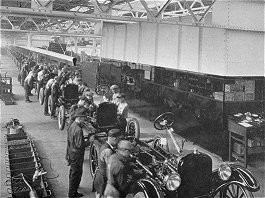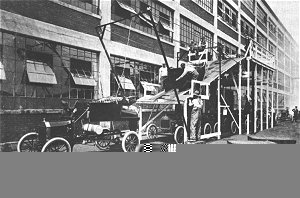|
The Barefoot Canoe Expedition, Idaho to New Orleans 1984 Barefoot Goldwinging – Most All of North America, 1997-2000 Voyages of the Barefoot Windwalker Across the North Atlantic Getting Out and Getting Under in the Good Ol' US of A
THE
The next step to enable lowering the cost of the Model T, which had been introduced at $850 for the passenger body styles, was to perfect (as opposed to invent) the moving assembly line. With the help of William Klann he built a mass production facility starting in 1909, which when completed in 1913 was producing at least 1000 vehicles per day. By using moving belts, workers could remain at one location and do one task well, rather than be counted on to cover a multitude of duties. In an attempt to literally put a Ford in every garage, Ford was able to bring the cost of a Model T down to $290 by 1915, a year in which he produced nearly half the world's automobiles. (By 1923 production was 1.8 million per year.)
The proliferation of the Model T over and above the combined production of all other cars (fifteen million were ultimately built by 1927) required a network of new roads, petrol stations, traffic control, and a variety of other new or expanded industries, not the least of which was tourism. It also was responsible for the initial growth of suburban areas around major cities. The down side of this assembly line methodology were that it reduced the necessary skill set of the average worker making each employee less viable, created an environment for repetitive work injuries, and turned employees into robots of sorts, making them effectively indistinguishable from the machines in the plant.
However, the "Tin Lizzie" as it was affectionately dubbed was also durable and versatile. The basic frame could be used as a touring car, pickup, delivery van, fire engine, paddy wagon, ambulance, taxi, school bus, farm vehicle, and even a camper. They were also basic enough that most owners could also be their own mechanic. While the Model T barely exists in the memory of the younger generations now, there are many avid and active Model T collectors and clubs throughout the world, with about 200,000 running and working Model T's and TT trucks. It will always be the progenitor of today's automobile industry and manufacturing methods. It Put The World On Wheels! Something to think about -- Considering inflation since Henry Ford introduced assembly line methods to production, gold in 1914 was $19 an ounce. and now it is $650 per ounce, an inflation of 34 times. The Model T Ford Sedan sold for $975, the equivalent of $33,000 today, which buys a far superior car with all the bells and whistles. Even gasoline is cheaper and better. A very low grade gasoline in 1914 was $0.10 to $0.12 per gallon (with no federal or state taxes), today's price for a very much better fuel at $3.20 per gallon is very much a bargain. All consumer goods are better and cheaper today that they were then, thanks to Henry Ford and the assembly line. The Model T
On the Web April 2007 in the Spirit of Adventure Three mighty important things, Pardn'r, LOVE And PEACE and ADVENTURE in LIFE |





